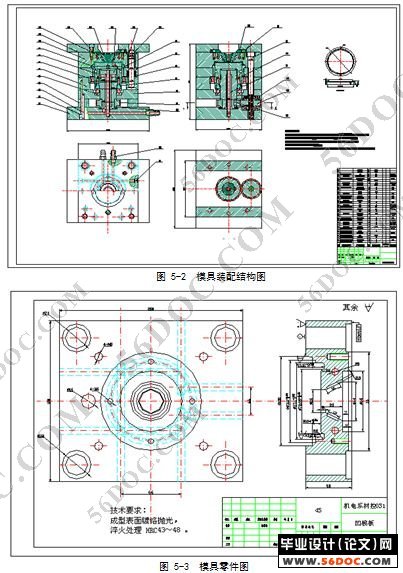摘 要
本文是关于大油壶盖注塑模具的设计,针对的主要是模具成型中的自动脱螺纹方法。在正确分析塑件工艺特点和HDPE的性能的基础上,采用了最简单的绝热流道结构——井坑试喷嘴模具。介绍了对螺纹型芯,凹模,浇注系统,脱模机构,选择标准零件,设计非标件的设计过程。涉及模具结构、强度、寿命计算及熔融塑料在模具中流动预测等复杂的工程运算问题;运用了(CAD)、辅助制造(CAM)、辅助工程(CAE)等不同的软件分别对模具的设计、制造和产品质量进行分析。大油壶盖注射模具设计,采用一般精度,利用CAD、CAE、CAM来设计或分析注射模的成型零部件,浇注系统,导向部件和脱模机构等等。综合运用了专业基础、专业课知识设计,其核心知识是塑料成型模具、材料成型技术基础、机械设计、塑料成型工艺、计算机辅助设计、模具CAD\CAM\CAE等。
关键词: 熔融塑料 ,绝热流道, 螺纹型芯, 长导程螺杆,脱模机构。
ABSTRACT
This is the lard on the handle of the plastic injection mold design, which is mainly aimed at the Molding of Automatic Screw methods. I choice the most simple structure must Abstracts -- pits trial nozzle mold on the basis of The correct analysis of the characteristics of plastic parts and the performance of HDPE. This article includes the design process of thread core, die, casting system, stripping institutions, the selection criteria parts, and the non-standard pieces . It also involve many Project Operational issues :mold structure, strength, life calculation and forecast the flow of melting plastic in the mold. At the same time, analyses the design, manufacture and product quality of the mold with (CAD), aided manufacturing (CAM), aided engineering (CAE) software in a wide variety. In the design process ,I use CAD, CAE and CAM to design or analysis the injection mold parts of the molding, casting systems, components ,guidance Demoulding institutions and so on ,following the usual precision . I use the expertise integratedly in the design process too,while the Core Knowledge is the plastic mold, molding material and technological foundation for mechanical design, plastic molding technology, computer-aided design, CAD \ CAM \ CAE, etc..
Key word: Fusing plastic heat insulation flow channel thread core, long lead screw, drawing of patterns organization.
名称:大油壶盖
材料:HDPE
技术要求:
1.大批量生产。
2.自动脱螺纹
3. 采用塑料制件尺寸公差(SJl372-78) 7级精度





目录 20000字
中文摘要 ……………………………………………………………………………………Ⅰ
英文摘要 ……………………………………………………………………………………Ⅱ
第一章 概述 ……………………………………………………………………………… 1
1.1国际塑料模具工业的发展的新动态 ………………………………………………… 1
1.2我国模具工业发展现状 …………………………………………………………… 3
1.3我国模具设计技术今后发展方向 …………………………………………………… 5
1.4毕业设计课题资料查询……………………………………………………………… 5
1.4.1分析塑件结构及工艺技术要求 ……………………………………………………6
1.4.2了解塑件的加工性能和工艺性能 …………………………………………………6
1.4.3塑料的适用范围……………………………………………………………………6
1.4.4塑件收缩及补缩问题,尽量减少残余内应力和翘曲变形……………………………6
1.4.5注塑工艺及模具条件………………………………………………………………7
1.4.6模具材料 …………………………………………………………………………7
1.4.7模具的热量损耗,冷却水用量,生产效率…………………………………………7
1.5毕业设计思想简述 ……………………………………………………………………7
第二章 塑料制件的工艺性分析及工艺结构设计………………………………………9
2.1成型塑料制件结构工艺性分析………………………………………………………… 9
2.2 塑件三维CAD建模及CAE分析 ………………………………………………………10
2.2.1利用CAD建模,完成三维零件的设计 ……………………………………………10
2.2.2 CAE分析及其结果 ……………………………………………………………10
2.3根据CAE分析结论进行模具工艺设计……………………………………………………14
2.3.1.型腔数量的决定 …………………………………………………………………14
2.3.2型腔布置 ………………………………………………………………………14
2.3.3确定分型面 ……………………………………………………………………14
2.3.4 主流道和主流道衬套结构设计…………………………………………………16
第三章 选择注射机及注射机工艺参数校核 ……………………………………… 19
3.1注塑机的技术规范……………………………………………………………………19
3.2最大注射量的校核……………………………………………………………………19
3.3注塑压力的核核………………………………………………………………………20
3.4锁模力的校核…………………………………………………………………………20
3.5 模具闭合高度校核……………………………………………………………………21
第四章 模具设计 ………………………………………………………………………22
4.⒈确定标准注塑模架……………………………………………………………………22
4.2模具成型零件设计 ……………………………………………………………………22
4.2.1凹模(阴模)的结构设计 …………………………………………………………22
4.2.2型芯的结构设计 …………………………………………………………………22
4.2.3确定模具零件厚度及外形尺寸………………………………………………………23
4.2.4排气方式及排气孔的设计 ………………………………………………………23
4.3型腔成型尺寸计算 ……………………………………………………………………24
4.3.1塑件精度影响误差值的确定 ………………………………………………………24
4.3.2按平均收缩率计算成型尺寸 ………………………………………………………24
4.3.3型芯径向尺寸计算 ………………………………………………………………25
4.3.4型腔深度尺寸计算 ………………………………………………………………26
4.3.5型芯高度尺寸的计算 ……………………………………………………………27
4.4脱模机构的设计 ……………………………………………………………………28
4.5模具冷却系统设计 ……………………………………………………………………30
4.5.1注射模冷却系统设计的原则 ………………………………………………………30
4.5.2模具热平衡计算 …………………………………………………………………31
4.6模具主要连接、定位、导向件设计 ………………………………………………………33
第五章 绘制模具图 ……………………………………………………………………35
第六章 结论 ……………………………………………………………………………37
参考文献 ………………………………………………………………………………39
致谢 ………………………………………………………………………………40
|











